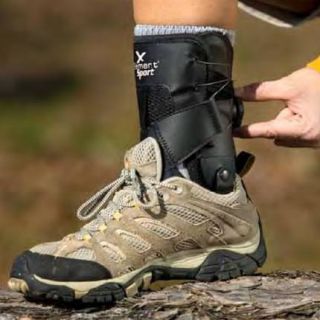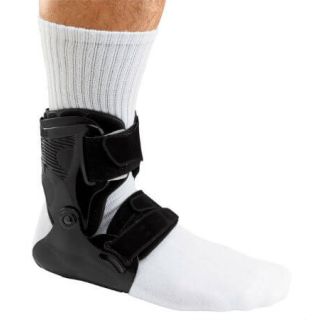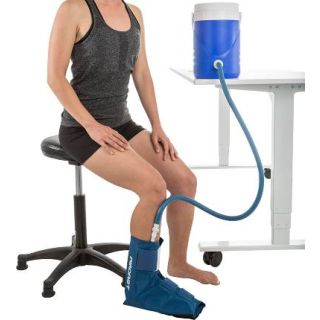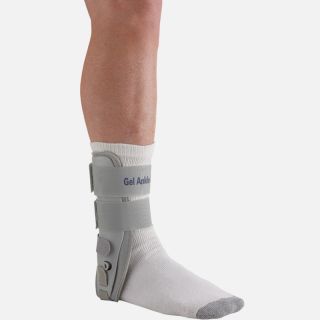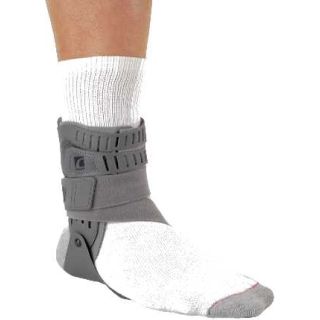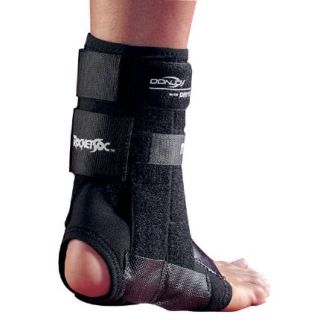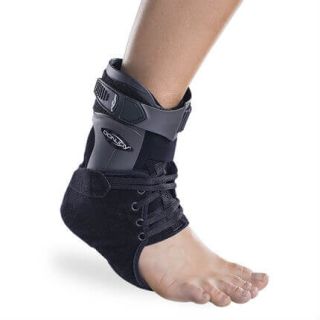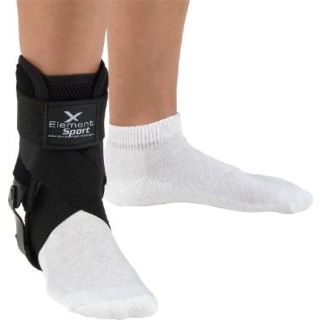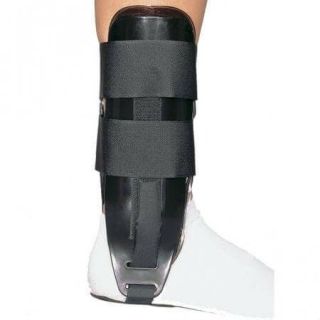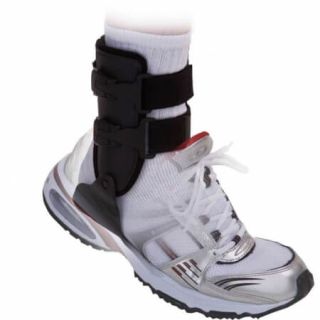Find the Right Support: Guide to High Ankle Sprain Braces
Dealing with an ankle sprain is never fun, but when it's a high ankle sprain, the recovery can feel even more challenging. Most ankle sprains happen on the outer side of your ankle. But a high ankle sprain is different. It affects the ligaments higher up, above the ankle joint, in a spot called the syndesmosis.
This important link between the two lower leg bones (tibia and fibula) is key for keeping your ankle stable. If it gets hurt, it needs special care and support to heal properly. If you're navigating the world of high ankle sprain braces and looking for the right high ankle sprain support to aid your recovery, this guide will help.
High Ankle Sprains: Why Support Matters
Before diving into the specifics of braces, let's quickly recap what a high ankle sprain entails. This type of ankle injury usually happens when you twist your ankle strongly, often turning your foot outward while your leg stays put.
Think of pivoting suddenly while your foot is planted or experiencing a forceful impact that pushes your foot upwards and outwards. This can stretch or tear the tough ligaments that hold the tibia and fibula together above the ankle joint.
Because these ligaments are critical for maintaining the stability of your ankle, a high ankle sprain often requires a longer healing time than a typical lateral sprain. Proper support is paramount to facilitate healing, reduce pain, and protect your ankle from further injury. This is where high ankle sprain support in the form of a brace comes into play.
Why Consider a Brace for Your High Ankle Sprain?
A well-chosen high ankle sprain brace can offer several key benefits during your recovery:
- Pain Reduction: By providing compression and limiting excessive movement, a brace can significantly reduce the pain associated with a high ankle sprain. This is especially helpful in the initial stages of injury when the area is most tender and inflamed.
- Stability and Support: The primary function of a high ankle sprain support is to stabilize the syndesmosis. By holding the tibia and fibula in proper alignment, the brace helps protect the injured ankle ligaments from further stress and promotes healing.
- Accelerated Healing: Limiting movement and providing consistent support can create an optimal environment for the damaged ligaments to repair themselves. This can potentially shorten your overall recovery time.
- Reduced Swelling: Many high ankle sprain braces offer compression, which can help to reduce swelling and inflammation in the injured area.
- Confidence and Gradual Return to Activity: As you progress through your recovery, a brace can provide the added support and confidence you need to gradually reintroduce weight-bearing activities and eventually return to your normal routine or sport.
Types of High Ankle Sprain Braces
When searching for the right high ankle sprain brace, you'll encounter various types of supports. Understanding the differences between them is crucial for making the best choice for your specific needs.
While some general ankle braces might offer some level of support, those specifically designed for high ankle sprains will provide targeted stabilization above the ankle joint. Here are some common categories:
- Compression Sleeves: These elastic sleeves primarily focus on reducing swelling and providing mild support. While they can be beneficial for general ankle health and mild sprains, they typically don't offer the specific stabilization needed for moderate to severe ankle sprains.
- Lace-Up Ankle Supports: These braces often feature laces and sometimes additional straps to provide adjustable support around the entire ankle. While they can offer good overall ankle stability, they may not provide the targeted compression and stabilization above the ankle joint that is crucial for high ankle sprains.
- Stirrup Braces: These braces have rigid or semi-rigid sides (stirrups) that run along the medial (inner) and lateral (outer) sides of the ankle, connected by adjustable straps. They are excellent for providing side-to-side stability but may lack the specific support needed for the syndesmosis in a high ankle sprain.
- Specialized High Ankle Sprain Braces: These are specifically designed to address the unique needs of a high ankle sprain. They often feature adjustable straps that wrap around the lower leg above the ankle joint, providing direct compression and stabilization to the syndesmosis. Some may also incorporate rigid or semi-rigid components to further limit movement between the tibia and fibula. These are often considered the most effective type of high ankle sprain support for moderate to severe injuries.
- Walking Boots: In more severe cases of high ankle sprains, or when a fracture is suspected or present, your doctor may recommend a walking boot instead of or in addition to a brace. Walking boots provide significant immobilization and support to the entire lower leg and ankle.
Key Features to Look for in Your High Ankle Sprain Brace
When choosing a high ankle sprain brace, consider these important features:
- Targeted Syndesmosis Support: The brace should have features that specifically address the area above the ankle joint, where the syndesmosis is located. Look for adjustable straps or compression systems that focus on this region.
- Adjustability: The ability to adjust the compression and fit of the brace is crucial for comfort and effectiveness. You'll want to be able to customize the level of support based on your swelling and activity level.
- Comfort: You'll likely be wearing the brace for extended periods, so comfort is essential. Look for breathable materials and a design that doesn't cause excessive rubbing or irritation.
- Durability: Choose a brace made from high-quality materials that can withstand regular use throughout your recovery.
- Ease of Use: The brace should be relatively easy to put on and take off, especially if your mobility is limited.
Making the Right Choice: Consulting Your Doctor and Considering Your Needs
While this guide provides valuable information, it's crucial to remember that the best high ankle sprain support for you will depend on the severity of your injury and your individual needs. Always consult with your doctor or a physical therapist for a proper diagnosis and personalized treatment plan. They can assess the grade of your sprain and recommend the most appropriate type of brace and the duration of its use.
Consider the following factors when discussing brace options with your healthcare provider:
- Severity of your sprain: Mild sprains might benefit from a less restrictive brace, while more severe sprains may require a more supportive and immobilizing option.
Your activity level: If you are an athlete looking to return to high-impact sports, you may need a more robust and supportive brace during the later stages of recovery and potentially even for ongoing support.
- Your comfort preferences: Some people prefer softer, more flexible braces, while others need the rigid support of a more structured brace. Discuss your preferences with your doctor.
Using Your High Ankle Sprain Brace Correctly
Once you've chosen the right high ankle sprain brace, it's important to use it correctly. Always follow the manufacturer's instructions for application and wear. Ensure the brace is snug but not so tight that it restricts circulation.
Your doctor or physical therapist will provide guidance on when and for how long you should wear the brace. Typically, you'll wear it most of the time during the initial healing phase and gradually reduce its use as your pain and swelling decrease and your strength improves.
Conclusion: Finding the Support You Need for Recovery
Recovering from a high ankle sprain requires patience and the right support. By understanding the different types of high ankle sprain braces available and considering the key features and your individual needs, you can make an informed decision that will aid your healing process and help you get back to your active life.
Remember to always consult with your healthcare provider for personalized advice and guidance throughout your recovery journey. With the right high ankle sprain support, you can confidently navigate your recovery and look forward to a full return to your favorite activities.
Need help finding a brace after spraining your ankle? Our bracing specialists and physical therapists can help you find a quality brace. Or use our Brace Guide to find a brace for your needs.
 Details$88.99 $79.99
Details$88.99 $79.99 Details$181.00 $181.00
Details$181.00 $181.00 Details$131.00 $131.00
Details$131.00 $131.00 Details$75.00 $75.00
Details$75.00 $75.00 Details$131.99 $121.99
Details$131.99 $121.99 Details$46.99
Details$46.99 Details$129.99 $97.99
Details$129.99 $97.99 Details$49.99 $36.99
Details$49.99 $36.99 Details$94.99 $85.99
Details$94.99 $85.99 Details$83.99 $71.99
Details$83.99 $71.99 Details$47.50 $28.99
Details$47.50 $28.99 Details$201.00 $201.00
Details$201.00 $201.00
